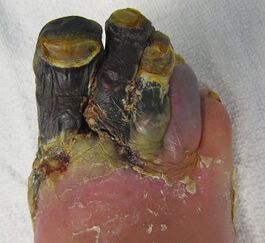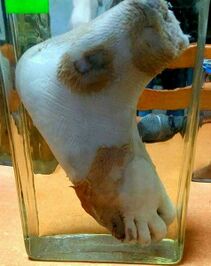Gangrene
This article is currently under review and may not be up to date. Please come back soon to see the finished work!
Introduction[edit | edit source]
Gangrene is the death of body tissues due to the loss of blood. It can be caused by illness, injury, or infection and usually happens in extremities like fingers, toes, and limbs. Gangrene can also occur in your organs and muscles [1].
Symptoms[edit | edit source]
Signs and symptoms of gangrene may include the following:
- Skin discoloration which can be from pale to blue, purple, black, bronze or red, depending on the type of gangrene you have
- Swelling
- Blisters
- Sudden, severe pain followed by a feeling of numbness
- A foul-smelling discharge leaking from a sore
- Thin, shiny skin, or skin without hair
- Fever and feeling unwell depending on the type of gangrene
Types of Gangrene[edit | edit source]
There are two main types of Gangrene:
- Dry Gangrene
Dry gangrene is frequently observed among patients who have vascular disease, diabetes and autoimmune diseases. It usually affects the hands and feet and happens when there is a poor blood circulation to a certain area. Therefore, the tissue that dries up changes color and can either turn brown, purplish-blue or black before the tissue can fall off. There is no infection associated to dry gangrene, but it can lead to wet gangrene if infected.
- Wet Gangrene
Gas Gangrene
References[edit | edit source]
- ↑ Gangrene. Available from: https://www.webmd.com/skin-problems-and-treatments/guide/gangrene-causes-symptoms-treatments ( September 11, 2021).








